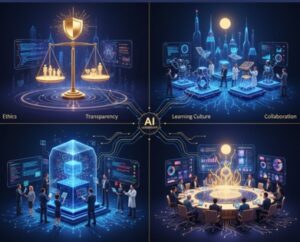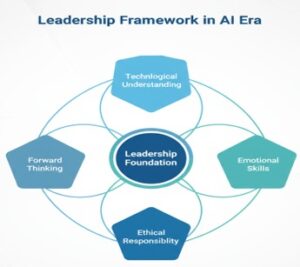In today’s fast-changing world, Artificial Intelligence (AI) is transforming industries, societies, and how organisations operate. This shift goes deep into leadership, where traditional approaches are being reshaped. Leading in this AI-driven era requires more than just usual management skills; it calls for a new mind-set that balances technological expertise with a focus on human values. Leaders who embrace this change will be better prepared to steer their organisations through an increasingly AI-enabled landscape.
The Heart of AI Leadership
At its essence, leadership in the age of AI involves blending technology with human skills to create adaptable, intelligent organisations. It is no longer solely about making decisions based on intuition—it now involves managing the collaboration between AI and humans, making use of data for precise insights, and handling the complexities that automation introduces. This new approach highlights the importance of flexibility, quick thinking, and ethical considerations, all while fostering a sense of psychological safety within teams.

What It Means to Lead During the AI Era
AI is not about replacing human leaders but enhancing their capabilities. Leaders need to develop a good understanding of AI’s possibilities and limitations, while also strengthening their emotional intelligence to build trust and motivate their teams. Combining AI-driven data analysis with human judgment enables faster and more informed decisions without losing sight of empathy and ethical values. Those who can master both these aspects will be at the forefront of responsible innovation, ensuring that people remain central to progress.
Exploring the Leadership Landscape
In the age of artificial intelligence, leadership now needs to encompass new areas:
- Implementing AI ethically to avoid misuse.
- Being transparent and addressing biases to build trust.
- Fostering cultures that value learning and experimentation, where failure is seen as part of growth.
- Encouraging collaboration across disciplines, bringing together experts in technology, strategy, and ethics to tackle complex problems.
Today’s leaders must act as coordinators of both advancing technologies and diverse human talents, shaping organisations that are inclusive, adaptable, and prepared for the future.

The Leadership Framework
Leadership in the AI era can be described through five key interconnected qualities:

- Technological Understanding – Knowing how AI works, its opportunities, and potential risks to make smart decisions.
- Emotional Skills – Developing trust, empathy, and resilience during rapid changes.
- Ethical Responsibility – Ensuring fairness and accountability in AI use.
- Flexibility – Being able to quickly change strategies when faced with disruptions.
- Forward Thinking – Anticipating future developments and inspiring others with a clear sense of purpose.
- These qualities together create a strong foundation, helping leaders balance immediate needs with long-term vision.
Balancing Technology and People:

One of the biggest challenges for leaders today is managing the delicate balance between precision and paradox. AI provides speed, scale, and accurate data, but leadership also involves navigating the uncertainties of human behaviour.
Leaders need to embrace contradictions: automation alongside human judgment, innovation paired with ethics, rapid action combined with reflection. Those who succeed at this balance foster environments where humans and AI work together smoothly.
For instance, while AI can forecast trends or improve decision-making, human empathy ensures these decisions reflect values, purpose, and social good. Effective AI leadership involves harnessing technology without losing sight of our human qualities.
Conclusion
Leadership in the era of AI represents a move away from old-fashioned authority towards a more collaborative, ethical, and adaptable approach driven by partnerships between humans and AI. Leaders need to be comfortable with technology while remaining deeply focused on human aspects, guiding teams and machines together to achieve common objectives. By adopting this new style of leadership, organisations can unlock the innovation, flexibility, and resilience necessary to thrive in the digital age.
The Way Forward
The way forward involves deliberately investing in leadership development that combines AI literacy with emotional intelligence, ethical considerations, and flexibility. Organisations should foster cultures that promote ongoing learning and psychological safety, encouraging leaders to try new approaches and grow. Valuing different viewpoints and working across disciplines will improve decision-making and spark innovation. Ultimately, the future belongs to leaders who blend technology with human qualities—making progress not only smarter but also more inclusive and ethical. Preparing leaders for this period will decide whether AI becomes a shared opportunity for growth or a missed one.





Leave a Reply